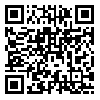BibTeX | RIS | EndNote | Medlars | ProCite | Reference Manager | RefWorks
Send citation to:
URL: http://umj.umsu.ac.ir/article-1-487-en.html
Received: 18 Aug, 2008 Accepted: 23 Sep, 2009
Background & Aims : Single Stranded Conformational Polymorphism as a molecular PCR based method has been significant for rapidly identification of fungal species. This method was previously used for the other aims including analysis of mutations as well as identification and discrimination between some organisms. In the present study, we tried to use the free digestion method of SSCP for discriminating Aspergilli in the species level considering polymorphism patterns between them.
Materials & Methods : Totally 205 Aspergillus strains were isolated from clinical and environmental specimens being collected in some Iranian approved hospitals and from medical mycology lab - School of Public Health , Tehran University of Medical Sciences. The sample size of this study was based on the prevalence 1% of Aspergillus infections among total of fungal nosocomial infections. All of the Aspergillus isolates, were identified by using four Aspergilli differential media including, CZA, CYA, CYA20S and MEA , followed by macroscopic and microscopic examinations. In the molecular assay, we extracted DNA manually using Glass beads and Phenol chloroform method, followed by PCR amplification of ITS2 region and then thermal denaturizing DNA to make single stranded DNA . Finally, we compared differentiate patterns of electrophoresis bands.
Results : During an 18 month study, we obtained 205 Aspergillus isolates including 11 species, from the hospital and environmental specimens. Hospital sources included clinical (25%) and environmental (75%) isolates. Our findings of SSCP method included: A. nidulans, A. fischeri, A. quadricincta, (A.fumigatus, A. niger ) as a category and (A. flavus, A. terreus, A. ochraceus) as the other category.�
Conclusion : SSCP as a rapid and simple molecular method enabled us to identify most important pathogenic Aspergillus species. The above technique is not commonly used because of the low specificity.
Keywords : Aspergillus, Identification, Polymorphism
Address: Department of Physiology, Faculty of Medicine, Urmia University of Medical Sciences, Nazlou Road, Nazlou Academic Campus, Urmia, Iran Tel: (+98 441) 2770969
E-mail: kadiba@umsu.ac.ir
Source: UMJ 2009: 20(3): 232 ISSN: 1027-3727
| Rights and permissions | |
 |
This work is licensed under a Creative Commons Attribution-NonCommercial 4.0 International License. |





